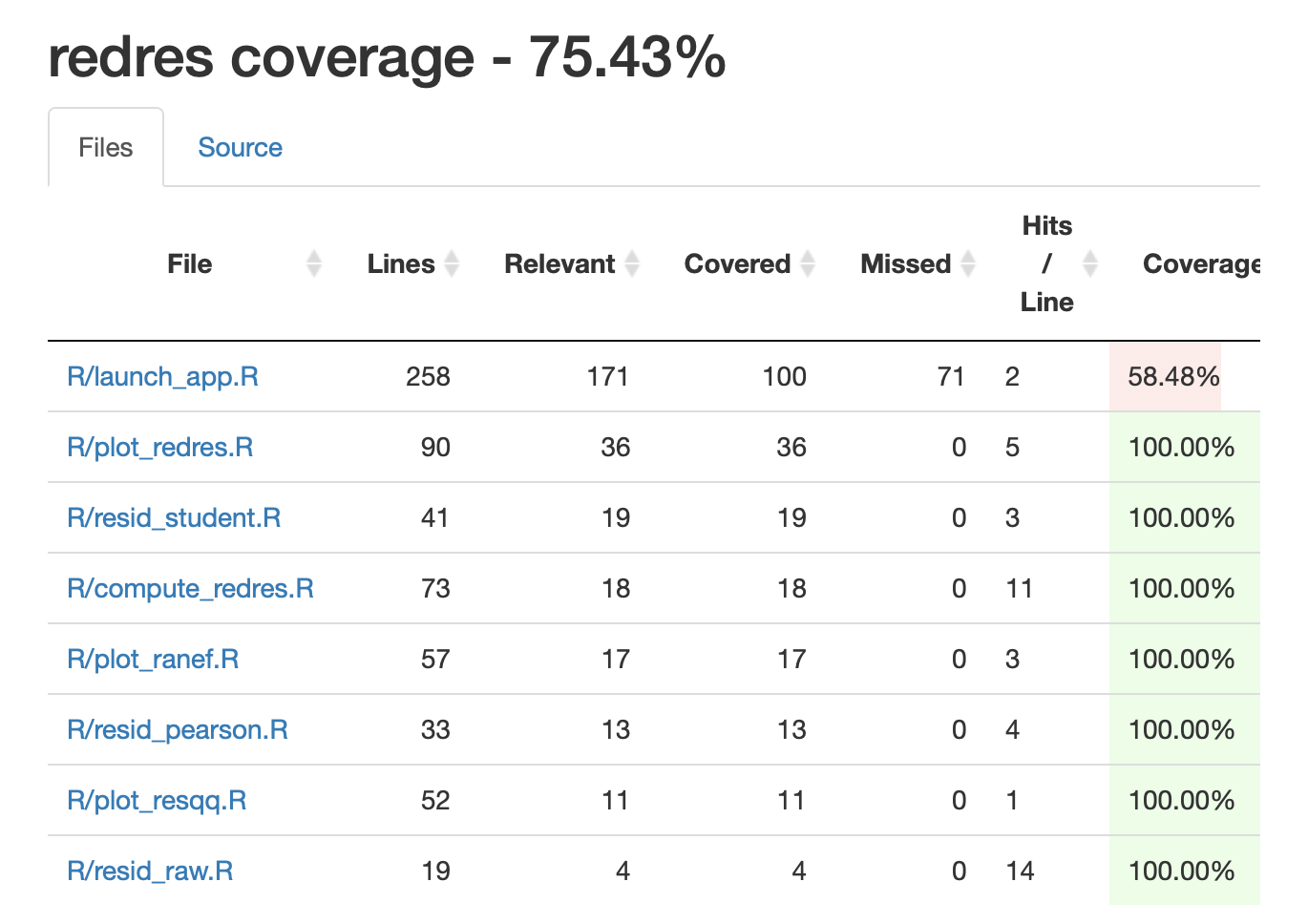redres is an R package developed to help with diagnosing linear mixed models fit using the function lmer from the lme4 package. It is meant to supplement the lme4 package.
Note that the code coverage is less than 90% due to our function launch_app that runs the Shiny app. The other functions in the package all have 100% code coverage. See the image below of the coverage report (taken on May 6, 2019).

Installation
redres can be installed from the GitHub repository using the devtools package.
# Installs redres
devtools::install_github("goodekat/redres")Once installed, the package can be loaded as usual.
# Loads the library
library(redres)Functions
The package contains the following functions.
compute_redres
compute_redres computes residuals given an lmer model and a specified residual type. The available residual types are listed below.
-
"pearson_cond": Pearson conditional residuals -
"pearson_mar": Pearson marginal residuals -
"raw_cond": raw conditional residuals (default) -
"raw_mar": raw marginal residuals -
"std_cond": studentized conditional residuals -
"std_mar": studentized marginal residuals
# fits an lmer model
library(lme4)
m <- lmer(Reaction ~ Days + (Days | Subject), data = sleepstudy)
# computes the default residuals (raw conditional)
rc_resids <- compute_redres(m)
# computes the Pearson marginal residuals
pm_resids <- compute_redres(m, type = "pearson_mar")
# computes the studentized conditional residuals
sc_resids <- compute_redres(m, type = "std_cond")
# puts the residuals in a data frame with observed response and prints the first six rows
resids <- data.frame(sleepstudy$Reaction, rc_resids, pm_resids, sc_resids)
head(resids)## sleepstudy.Reaction rc_resids pm_resids sc_resids
## 1 249.5600 -4.102638 -0.05183946 -0.1827204
## 2 258.7047 -14.624497 -0.08779115 -0.6273252
## 3 250.8006 -42.195157 -0.57418908 -1.7645439
## 4 321.4398 8.777483 0.97112562 0.3616111
## 5 356.8519 24.523024 1.48696343 1.0048545
## 6 414.6901 62.694664 2.39619943 2.5789296plot_redres
plot_redres creates a plot (using ggplot2) of the residuals versus the fitted values given a model and a specified residual type. All residual types listed for redres work with plot_redres.
# creates a plot of the conditional studentized residuals versus the fitted values
plot_redres(m, type = "std_cond")
plot_resqq
plot_resqq creates a normal quantile plot (using ggplot2 and qqplotr) of the raw conditional residuals, raw_cond. By the assumptions of a model fit using lmer these residuals are expected to be normally distributed. Obvious departures indicate an invalid assumption. See vignette for more details about interpreting quantile plots.
# creates a residual quantile plot for the error term
plot_resqq(m)
plot_ranef
plot_ranef creates normal quantile plots for all random effects in the model. Under the assumptions of a lmer model, each random effect term is normally distributed. This function will return a grid of plots fit using ggplot2 and qqplotr.
# creates normal quantile plots for each random effect
plot_ranef(m)
launch_redres
launch_redres opens a Shiny app that includes interactive panels to view the diagnostic plots from a model. The function can be used by inputting one or two models into the app in the form of a vector. If two models are input, the residual plots for each model will be shown side by side in the app. Screen shots of the app are shown below.
# opens the app
launch_redres(m)


Learn More
To learn more about redres, read through the vignette for redres which contains:
- details on how the residuals are computed
- explanations of how to use the different residual types
- interpretations of the plots
- examples using
redresto assess the assumptions of a linear mixed model
Additionally, more information is available at the package website.
